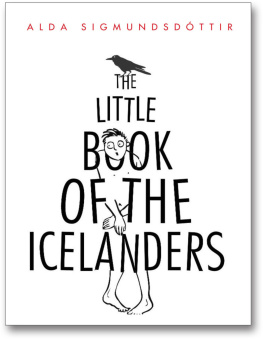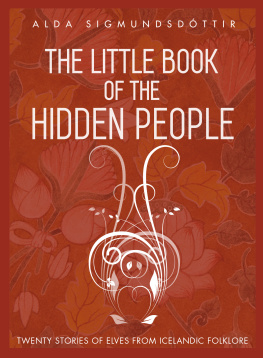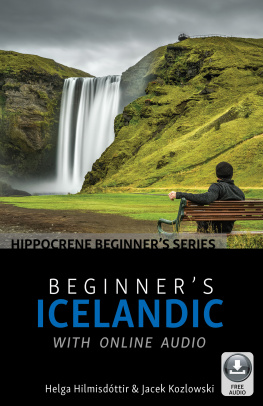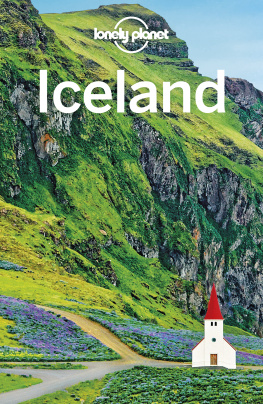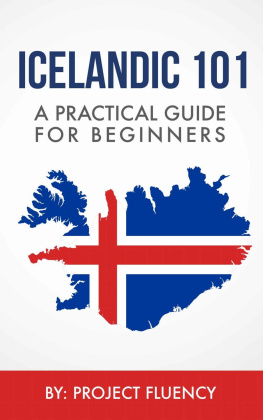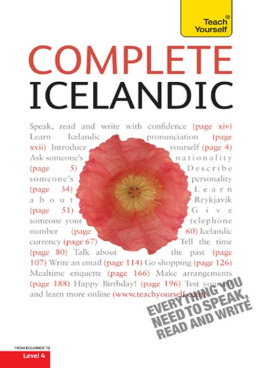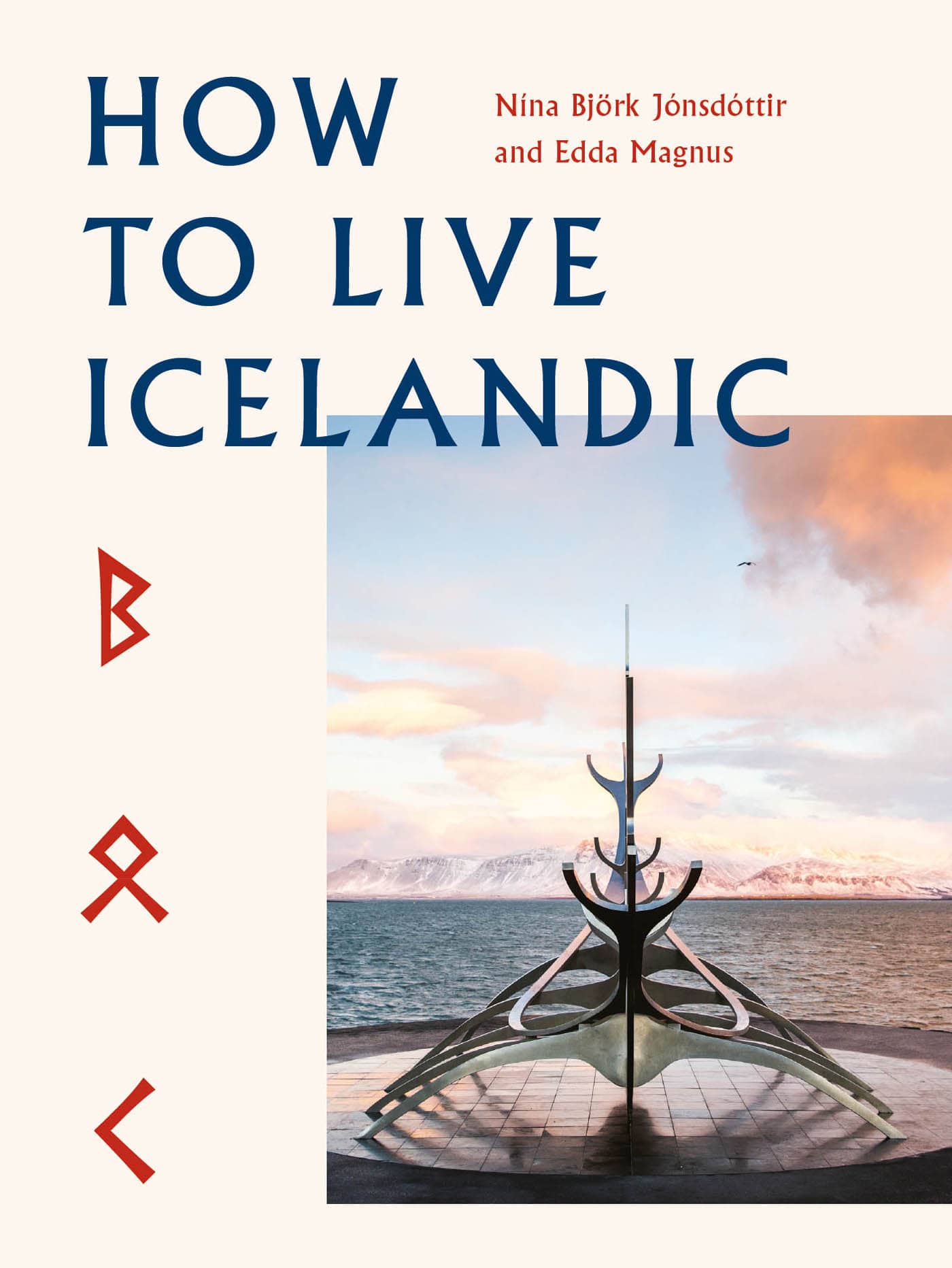Contents
Page List
Guide
Cover
HOW TO LIVE ICELANDIC
Nna Bjrk Jnsdttir and Edda Magnus
Introduction
How can one describe what it means to call somewhere home?
The feeling of lying on a soft bed of sun-baked moss covering an ancient lava field.
The sweet smell of a birch forest just after the rain.
The salty wind, so strong it takes your breath away, that never fails to welcome you home when you step out of Keflavk Airport.
The waves of goosebumps over your body as you step into the warm hot tub after the run from the showers to the outdoor pool.
The buzzing energy of a bright summer's night when you stumble out of a nightclub at 3 a.m.
The stillness of a frozen winter's night when the only sound is the snow crackling under your feet as the northern lights dance in the sky above you.
The warm feeling of belonging when the clock strikes midnight on New Years Eve and everyone in your street, your town and your country joins you in the celebration.
The overwhelming sense of relief and gratitude when the local farmer skips dinner to come outside and tow your car out of a ditch during a snowstorm.
In this book, we attempt to bring Iceland, the place we call home, to life with all its sensations. Journeying through breathtaking landscapes, tiny coastal villages and the bustle of Reykjavk, we will explore Icelands favourite foods, pastimes and the major milestones and festivities in our lives. We will celebrate our athletes, artists, writers and musicians, as well as Icelands role as a world leader in sustainability, renewable energy and gender equality.
The incredible and unpredictable nature at our doorstep; the freedom of an Icelandic childhood; belonging to a close-knit society where every individual can thrive; our ability to not take ourselves too seriously; and our stoically optimistic approach to life, which has helped us survive centuries of poverty, bad weather and natural disasters: these are the unique qualities that make us who we are. This is how to live Icelandic.
AREAS OF ICELAND
Land of Fire and Ice
In geological terms, Iceland is very young: a country still in the making. The earth is about 4.5 billion years old, but the oldest rock in Iceland is only around 16 million years old. The country sits on the Mid-Atlantic Ridge, where the Eurasian and North American tectonic plates are slowly drifting apart, tearing Iceland in opposite directions to the west and east by around 2 centimetres (0.8 inches) a year. The juncture lies through the middle of the country, where volcanic activity is concentrated, making the western and easternmost parts of Iceland the oldest.
In many ways, Iceland is a living textbook on geology. If you look out of the airplane window when approaching Keflavk Airport, you can see cracks in the lava field below all running in the same direction. It looks a bit like a cake that has been left for too long in the oven. The landscape at ingvellir National Park is testament to this, with its ravines and rock walls all lined in the same direction. The plates on the ocean floor stretch in opposite directions, causing tension to build up in the earths crust that is released through earthquakes and volcanic eruptions, forming the Mid-Atlantic Ridge. Beneath Iceland is an additional mantle plume with even more volcanism, causing the island to rise out of the ocean hence land of fire.
As the name suggests, Iceland is also a country of ice (although not as much as nearby Greenland, despite their names!). Its high latitude, just below the Arctic Circle (although the Circle does go through Grmsey island), accounts for roughly 10 per cent of Iceland being covered with glaciers. Some of Icelands most active volcanoes, such as Grmsvtn and Katla, are located under glaciers.

There are some common misconceptions about Iceland. Firstly, it is not as cold as you might think. We have the Gulf Stream to thank for that the ocean current that brings warm water from the Gulf of Mexico into the Atlantic Ocean, making the climate in Iceland much warmer in winter than it would otherwise be. Winters in Iceland tend to be mild, while the summers are cool. The average temperature in Reykjavk is about 0C (32F) in the coldest months and 11C (52F) at the peak of summer. It might sound like we have the same climate all year, but as an old Icelandic joke goes, if you dont like the weather, just wait for five minutes. On any given day, you could have rain, wind, snow, hail and sun thrown at you within a very short time. The forecast has to be quite good for Icelanders to consider leaving the house without a coat.
Another misconception is that Iceland is small. In actual fact, it covers 103,000 square kilometres (40,000 square miles), so its larger than many European countries, including Hungary, Austria and Portugal (each, not combined). This allows quite a lot of space for around 370,000 inhabitants, making Iceland the least densely populated country in Europe.
The Sea Gives, the Sea Takes
Almost all Icelanders live on the coast, of which about two-thirds are located in and around the capital, Reykjavk. The rest of the population lives in towns and villages or on farms. Most towns tend to be rather small (between 5005,000 inhabitants is common) and they are often close to natural harbours.
Most Icelanders are used to seeing the ocean every day. However, our attitude towards it is perhaps different to other island nations. We see the water more as a workplace and source of food and revenue than a place for leisure. We are very conscious of the fact that the north Atlantic is dangerous. Seafaring was, until quite recently, a perilous undertaking. Most Icelanders have grown up with both fear and respect for the sea, an ambivalence summed up in the old saying, Hafi gefur, hafi tekur the sea gives, the sea takes.
However, our relationship with the sea is changing, not least due to increased safety. With improved technology, training, better equipment and protective gear, fishing has now become as safe as any other industry. Icelanders have also started to use the ocean for recreation, although our heated swimming pools hold more appeal. That said, some people have taken up sea bathing, even in winter, as many believe dipping your body into cold water is good for your health. It certainly feels exhilarating. An artificial geothermal beach has been created in Nauthlsvk in Reykjavk, where you can go straight into the hot tub or take a hot shower after bathing in the sea.



